Financial Control and Budgeting Report: NHS Funding and Control
VerifiedAdded on 2021/01/02
|20
|5663
|219
Report
AI Summary
This report provides a comprehensive analysis of financial control and budgeting within the National Health Service (NHS). It begins with an introduction to budgeting and financial planning, followed by an examination of recent legal, financial, and regulatory developments in health and social care, including the adoption of digital health services and the Health and Social Care Act 2012. The report explores various alternative funding options for the NHS, such as private finance initiatives, agency partnerships, tendering, and outsourcing. It also identifies and discusses stakeholders in the social care sector, including competitors, commissioners, government agencies, contributors, suppliers, and service users, along with effective communication methods. Furthermore, the report delves into agency theory, corporate governance, and accountability issues within the sector. The main body then proceeds to determine the break-even capacity usage rate, calculate targeted profit, and analyze break-even analysis in short-term and long-term decision-making. It further examines the advantages and disadvantages of various budgeting tools, difficulties in preparing public sector budgets, and the preparation of a cash budget. The report concludes by addressing the impact of financial constraints, costs, and budgets on health and social care service managers, clients, and other stakeholders, providing a complete overview of financial management within the healthcare sector.
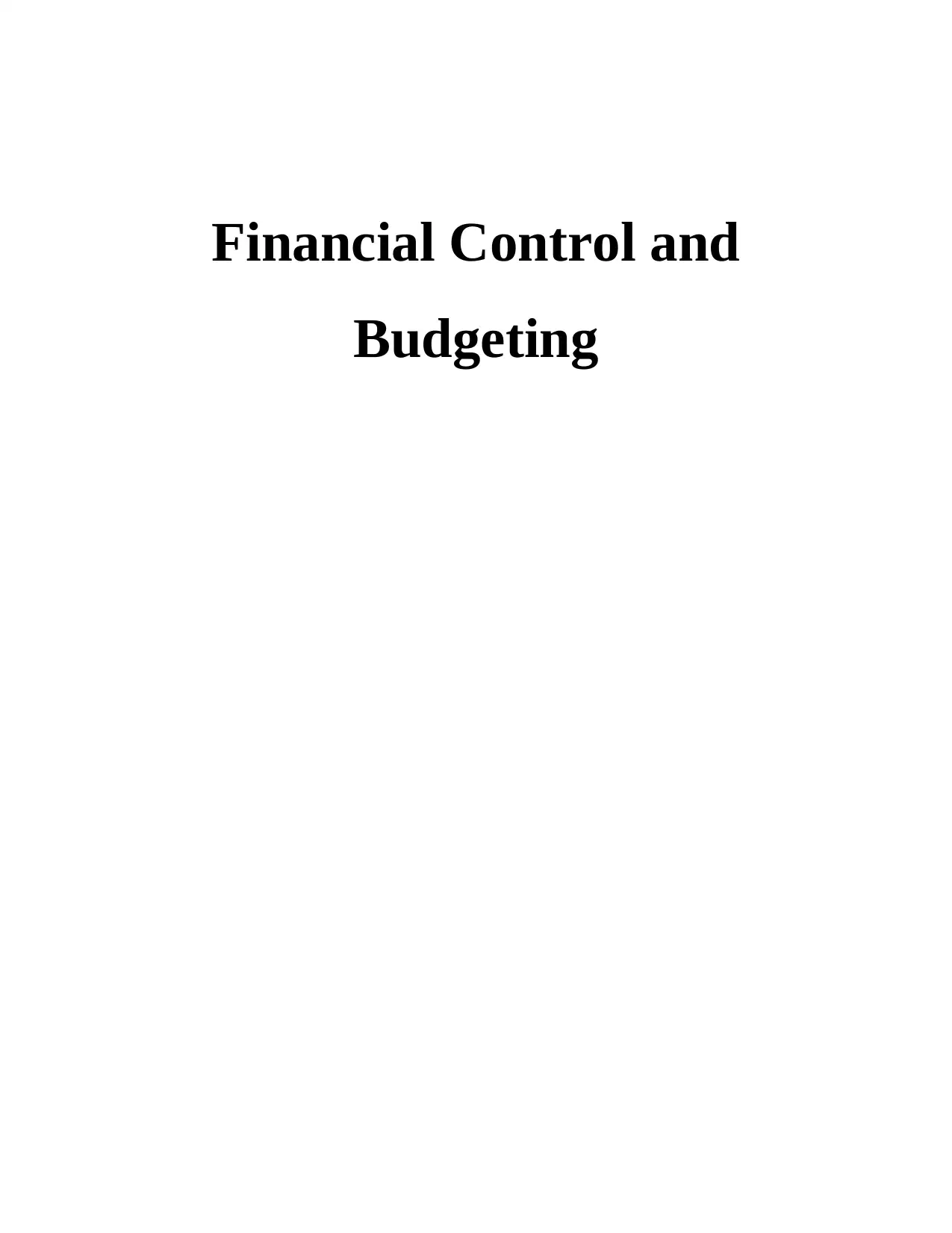
Financial Control and
Budgeting
Budgeting
Paraphrase This Document
Need a fresh take? Get an instant paraphrase of this document with our AI Paraphraser
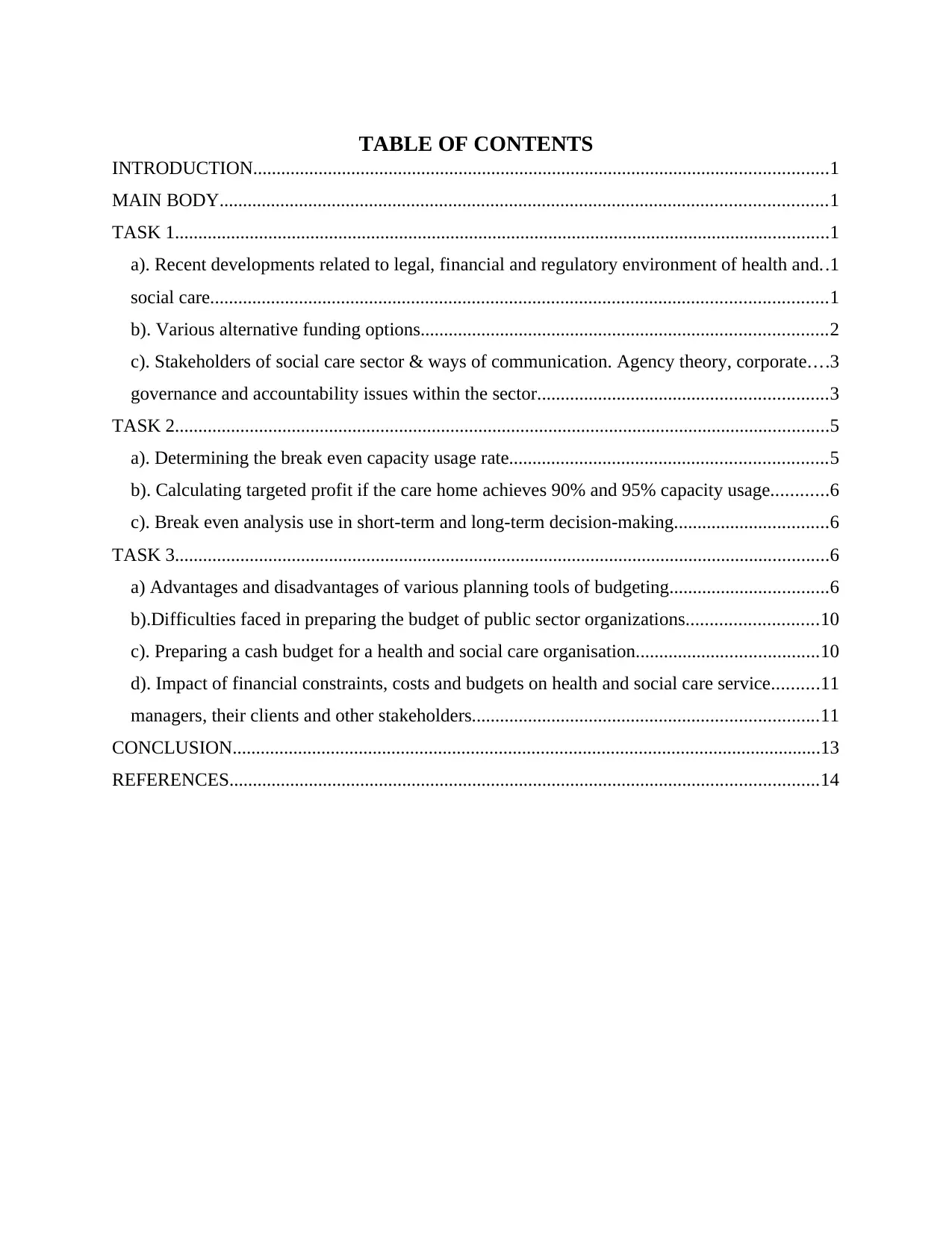
TABLE OF CONTENTS
INTRODUCTION...........................................................................................................................1
MAIN BODY..................................................................................................................................1
TASK 1............................................................................................................................................1
a). Recent developments related to legal, financial and regulatory environment of health and..1
social care....................................................................................................................................1
b). Various alternative funding options.......................................................................................2
c). Stakeholders of social care sector & ways of communication. Agency theory, corporate....3
governance and accountability issues within the sector..............................................................3
TASK 2............................................................................................................................................5
a). Determining the break even capacity usage rate....................................................................5
b). Calculating targeted profit if the care home achieves 90% and 95% capacity usage............6
c). Break even analysis use in short-term and long-term decision-making.................................6
TASK 3............................................................................................................................................6
a) Advantages and disadvantages of various planning tools of budgeting..................................6
b).Difficulties faced in preparing the budget of public sector organizations............................10
c). Preparing a cash budget for a health and social care organisation.......................................10
d). Impact of financial constraints, costs and budgets on health and social care service..........11
managers, their clients and other stakeholders..........................................................................11
CONCLUSION..............................................................................................................................13
REFERENCES..............................................................................................................................14
INTRODUCTION...........................................................................................................................1
MAIN BODY..................................................................................................................................1
TASK 1............................................................................................................................................1
a). Recent developments related to legal, financial and regulatory environment of health and..1
social care....................................................................................................................................1
b). Various alternative funding options.......................................................................................2
c). Stakeholders of social care sector & ways of communication. Agency theory, corporate....3
governance and accountability issues within the sector..............................................................3
TASK 2............................................................................................................................................5
a). Determining the break even capacity usage rate....................................................................5
b). Calculating targeted profit if the care home achieves 90% and 95% capacity usage............6
c). Break even analysis use in short-term and long-term decision-making.................................6
TASK 3............................................................................................................................................6
a) Advantages and disadvantages of various planning tools of budgeting..................................6
b).Difficulties faced in preparing the budget of public sector organizations............................10
c). Preparing a cash budget for a health and social care organisation.......................................10
d). Impact of financial constraints, costs and budgets on health and social care service..........11
managers, their clients and other stakeholders..........................................................................11
CONCLUSION..............................................................................................................................13
REFERENCES..............................................................................................................................14
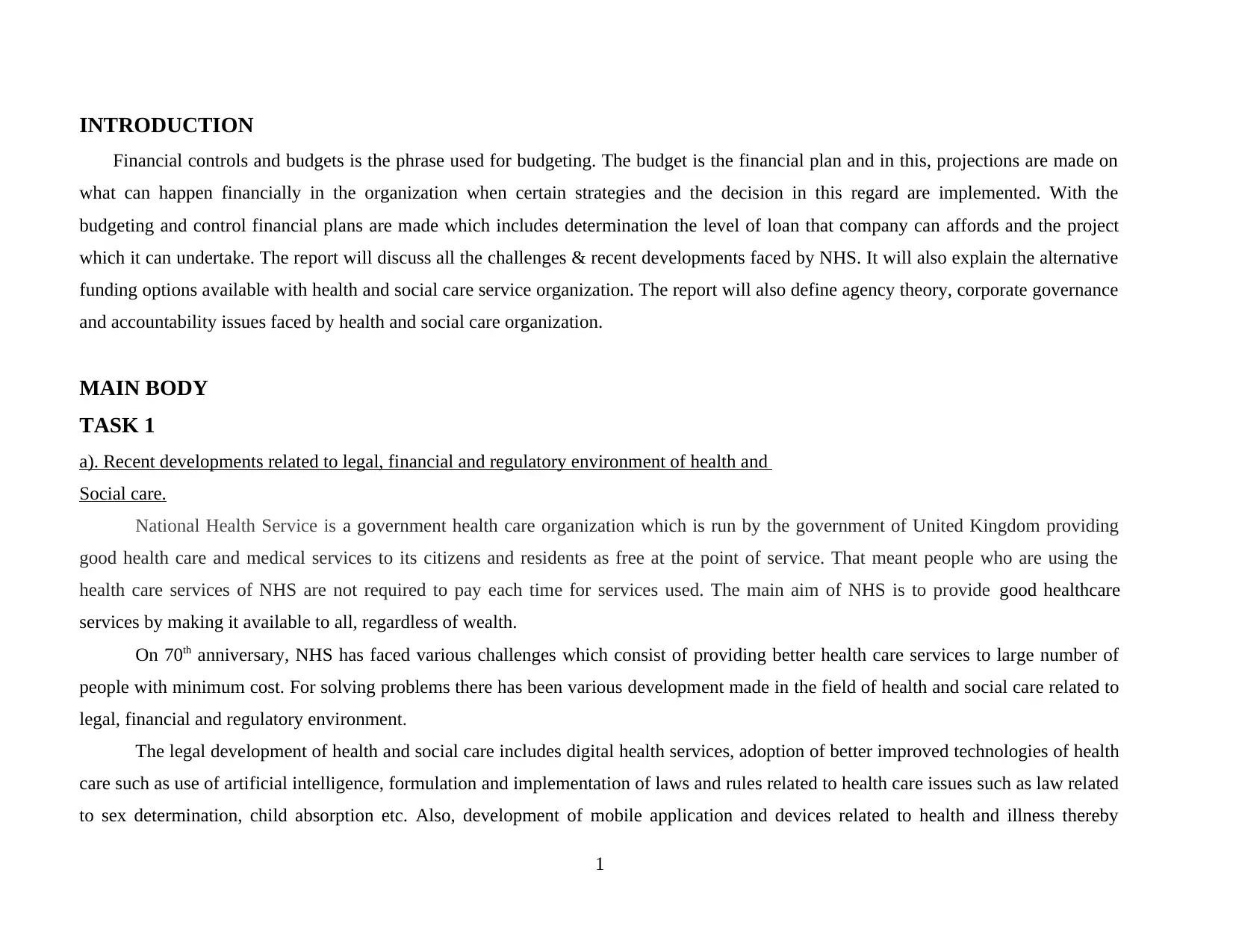
INTRODUCTION
Financial controls and budgets is the phrase used for budgeting. The budget is the financial plan and in this, projections are made on
what can happen financially in the organization when certain strategies and the decision in this regard are implemented. With the
budgeting and control financial plans are made which includes determination the level of loan that company can affords and the project
which it can undertake. The report will discuss all the challenges & recent developments faced by NHS. It will also explain the alternative
funding options available with health and social care service organization. The report will also define agency theory, corporate governance
and accountability issues faced by health and social care organization.
MAIN BODY
TASK 1
a). Recent developments related to legal, financial and regulatory environment of health and
Social care.
National Health Service is a government health care organization which is run by the government of United Kingdom providing
good health care and medical services to its citizens and residents as free at the point of service. That meant people who are using the
health care services of NHS are not required to pay each time for services used. The main aim of NHS is to provide good healthcare
services by making it available to all, regardless of wealth.
On 70th anniversary, NHS has faced various challenges which consist of providing better health care services to large number of
people with minimum cost. For solving problems there has been various development made in the field of health and social care related to
legal, financial and regulatory environment.
The legal development of health and social care includes digital health services, adoption of better improved technologies of health
care such as use of artificial intelligence, formulation and implementation of laws and rules related to health care issues such as law related
to sex determination, child absorption etc. Also, development of mobile application and devices related to health and illness thereby
1
Financial controls and budgets is the phrase used for budgeting. The budget is the financial plan and in this, projections are made on
what can happen financially in the organization when certain strategies and the decision in this regard are implemented. With the
budgeting and control financial plans are made which includes determination the level of loan that company can affords and the project
which it can undertake. The report will discuss all the challenges & recent developments faced by NHS. It will also explain the alternative
funding options available with health and social care service organization. The report will also define agency theory, corporate governance
and accountability issues faced by health and social care organization.
MAIN BODY
TASK 1
a). Recent developments related to legal, financial and regulatory environment of health and
Social care.
National Health Service is a government health care organization which is run by the government of United Kingdom providing
good health care and medical services to its citizens and residents as free at the point of service. That meant people who are using the
health care services of NHS are not required to pay each time for services used. The main aim of NHS is to provide good healthcare
services by making it available to all, regardless of wealth.
On 70th anniversary, NHS has faced various challenges which consist of providing better health care services to large number of
people with minimum cost. For solving problems there has been various development made in the field of health and social care related to
legal, financial and regulatory environment.
The legal development of health and social care includes digital health services, adoption of better improved technologies of health
care such as use of artificial intelligence, formulation and implementation of laws and rules related to health care issues such as law related
to sex determination, child absorption etc. Also, development of mobile application and devices related to health and illness thereby
1
⊘ This is a preview!⊘
Do you want full access?
Subscribe today to unlock all pages.

Trusted by 1+ million students worldwide
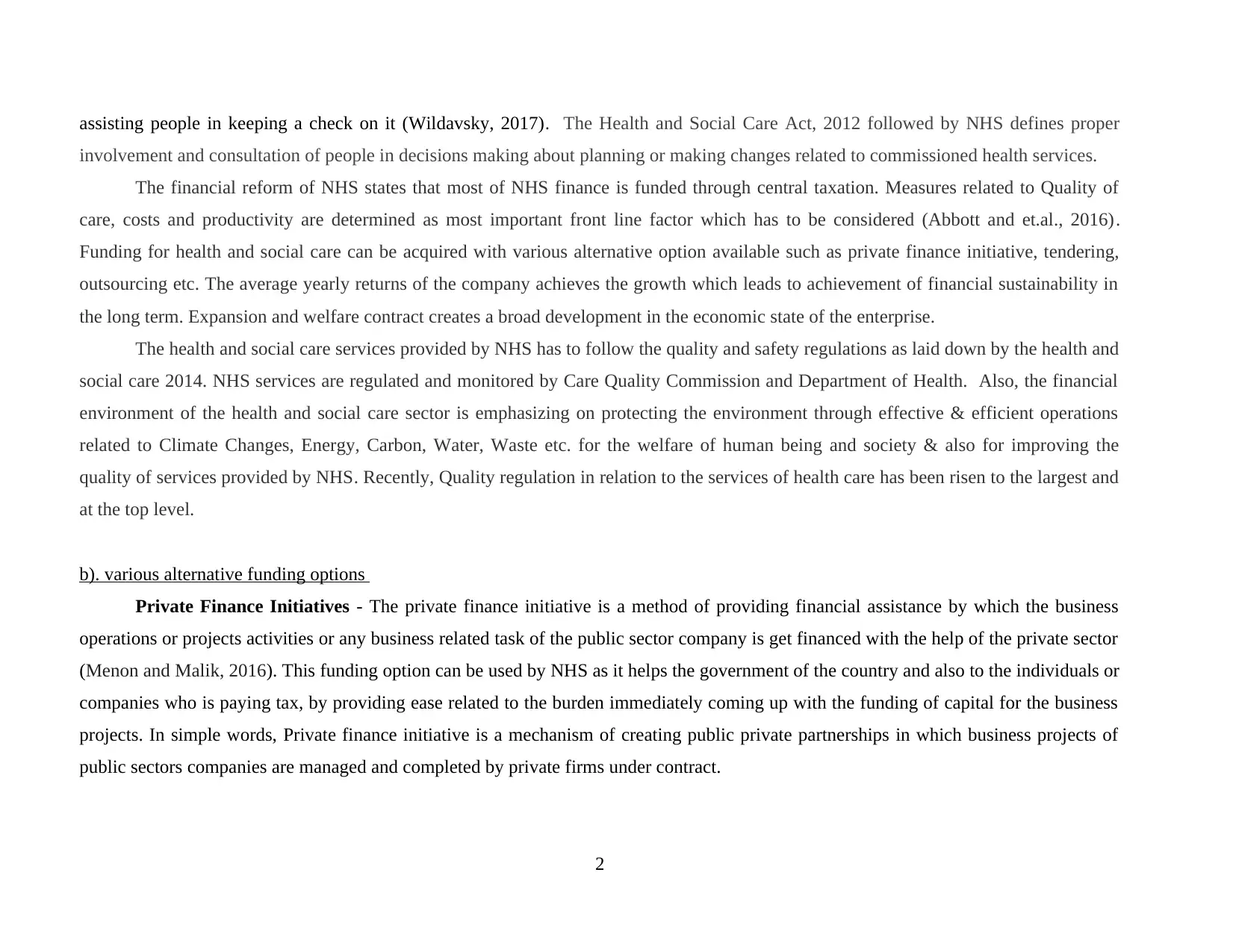
assisting people in keeping a check on it (Wildavsky, 2017). The Health and Social Care Act, 2012 followed by NHS defines proper
involvement and consultation of people in decisions making about planning or making changes related to commissioned health services.
The financial reform of NHS states that most of NHS finance is funded through central taxation. Measures related to Quality of
care, costs and productivity are determined as most important front line factor which has to be considered (Abbott and et.al., 2016).
Funding for health and social care can be acquired with various alternative option available such as private finance initiative, tendering,
outsourcing etc. The average yearly returns of the company achieves the growth which leads to achievement of financial sustainability in
the long term. Expansion and welfare contract creates a broad development in the economic state of the enterprise.
The health and social care services provided by NHS has to follow the quality and safety regulations as laid down by the health and
social care 2014. NHS services are regulated and monitored by Care Quality Commission and Department of Health. Also, the financial
environment of the health and social care sector is emphasizing on protecting the environment through effective & efficient operations
related to Climate Changes, Energy, Carbon, Water, Waste etc. for the welfare of human being and society & also for improving the
quality of services provided by NHS. Recently, Quality regulation in relation to the services of health care has been risen to the largest and
at the top level.
b). various alternative funding options
Private Finance Initiatives - The private finance initiative is a method of providing financial assistance by which the business
operations or projects activities or any business related task of the public sector company is get financed with the help of the private sector
(Menon and Malik, 2016). This funding option can be used by NHS as it helps the government of the country and also to the individuals or
companies who is paying tax, by providing ease related to the burden immediately coming up with the funding of capital for the business
projects. In simple words, Private finance initiative is a mechanism of creating public private partnerships in which business projects of
public sectors companies are managed and completed by private firms under contract.
2
involvement and consultation of people in decisions making about planning or making changes related to commissioned health services.
The financial reform of NHS states that most of NHS finance is funded through central taxation. Measures related to Quality of
care, costs and productivity are determined as most important front line factor which has to be considered (Abbott and et.al., 2016).
Funding for health and social care can be acquired with various alternative option available such as private finance initiative, tendering,
outsourcing etc. The average yearly returns of the company achieves the growth which leads to achievement of financial sustainability in
the long term. Expansion and welfare contract creates a broad development in the economic state of the enterprise.
The health and social care services provided by NHS has to follow the quality and safety regulations as laid down by the health and
social care 2014. NHS services are regulated and monitored by Care Quality Commission and Department of Health. Also, the financial
environment of the health and social care sector is emphasizing on protecting the environment through effective & efficient operations
related to Climate Changes, Energy, Carbon, Water, Waste etc. for the welfare of human being and society & also for improving the
quality of services provided by NHS. Recently, Quality regulation in relation to the services of health care has been risen to the largest and
at the top level.
b). various alternative funding options
Private Finance Initiatives - The private finance initiative is a method of providing financial assistance by which the business
operations or projects activities or any business related task of the public sector company is get financed with the help of the private sector
(Menon and Malik, 2016). This funding option can be used by NHS as it helps the government of the country and also to the individuals or
companies who is paying tax, by providing ease related to the burden immediately coming up with the funding of capital for the business
projects. In simple words, Private finance initiative is a mechanism of creating public private partnerships in which business projects of
public sectors companies are managed and completed by private firms under contract.
2
Paraphrase This Document
Need a fresh take? Get an instant paraphrase of this document with our AI Paraphraser
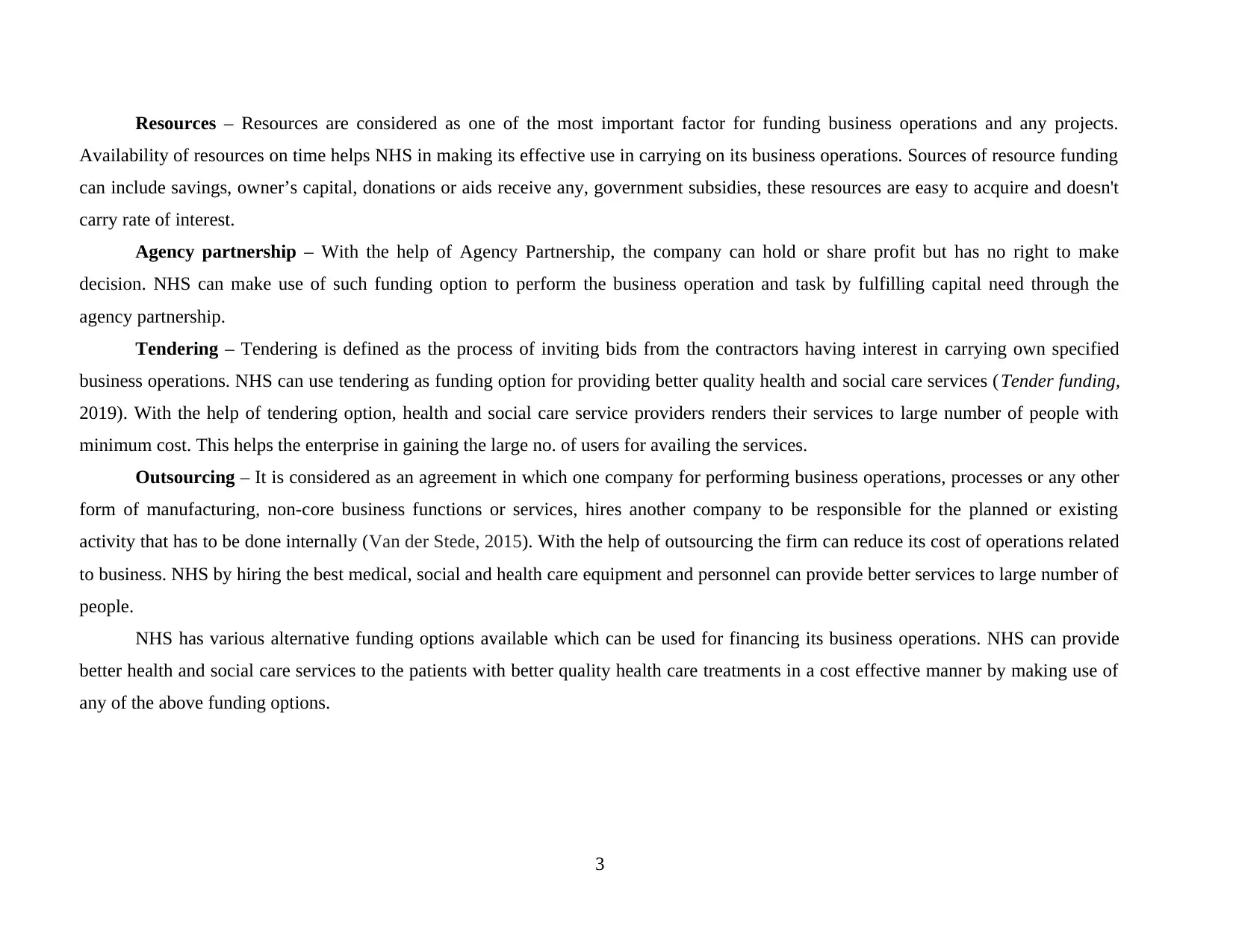
Resources – Resources are considered as one of the most important factor for funding business operations and any projects.
Availability of resources on time helps NHS in making its effective use in carrying on its business operations. Sources of resource funding
can include savings, owner’s capital, donations or aids receive any, government subsidies, these resources are easy to acquire and doesn't
carry rate of interest.
Agency partnership – With the help of Agency Partnership, the company can hold or share profit but has no right to make
decision. NHS can make use of such funding option to perform the business operation and task by fulfilling capital need through the
agency partnership.
Tendering – Tendering is defined as the process of inviting bids from the contractors having interest in carrying own specified
business operations. NHS can use tendering as funding option for providing better quality health and social care services ( Tender funding,
2019). With the help of tendering option, health and social care service providers renders their services to large number of people with
minimum cost. This helps the enterprise in gaining the large no. of users for availing the services.
Outsourcing – It is considered as an agreement in which one company for performing business operations, processes or any other
form of manufacturing, non-core business functions or services, hires another company to be responsible for the planned or existing
activity that has to be done internally (Van der Stede, 2015). With the help of outsourcing the firm can reduce its cost of operations related
to business. NHS by hiring the best medical, social and health care equipment and personnel can provide better services to large number of
people.
NHS has various alternative funding options available which can be used for financing its business operations. NHS can provide
better health and social care services to the patients with better quality health care treatments in a cost effective manner by making use of
any of the above funding options.
3
Availability of resources on time helps NHS in making its effective use in carrying on its business operations. Sources of resource funding
can include savings, owner’s capital, donations or aids receive any, government subsidies, these resources are easy to acquire and doesn't
carry rate of interest.
Agency partnership – With the help of Agency Partnership, the company can hold or share profit but has no right to make
decision. NHS can make use of such funding option to perform the business operation and task by fulfilling capital need through the
agency partnership.
Tendering – Tendering is defined as the process of inviting bids from the contractors having interest in carrying own specified
business operations. NHS can use tendering as funding option for providing better quality health and social care services ( Tender funding,
2019). With the help of tendering option, health and social care service providers renders their services to large number of people with
minimum cost. This helps the enterprise in gaining the large no. of users for availing the services.
Outsourcing – It is considered as an agreement in which one company for performing business operations, processes or any other
form of manufacturing, non-core business functions or services, hires another company to be responsible for the planned or existing
activity that has to be done internally (Van der Stede, 2015). With the help of outsourcing the firm can reduce its cost of operations related
to business. NHS by hiring the best medical, social and health care equipment and personnel can provide better services to large number of
people.
NHS has various alternative funding options available which can be used for financing its business operations. NHS can provide
better health and social care services to the patients with better quality health care treatments in a cost effective manner by making use of
any of the above funding options.
3
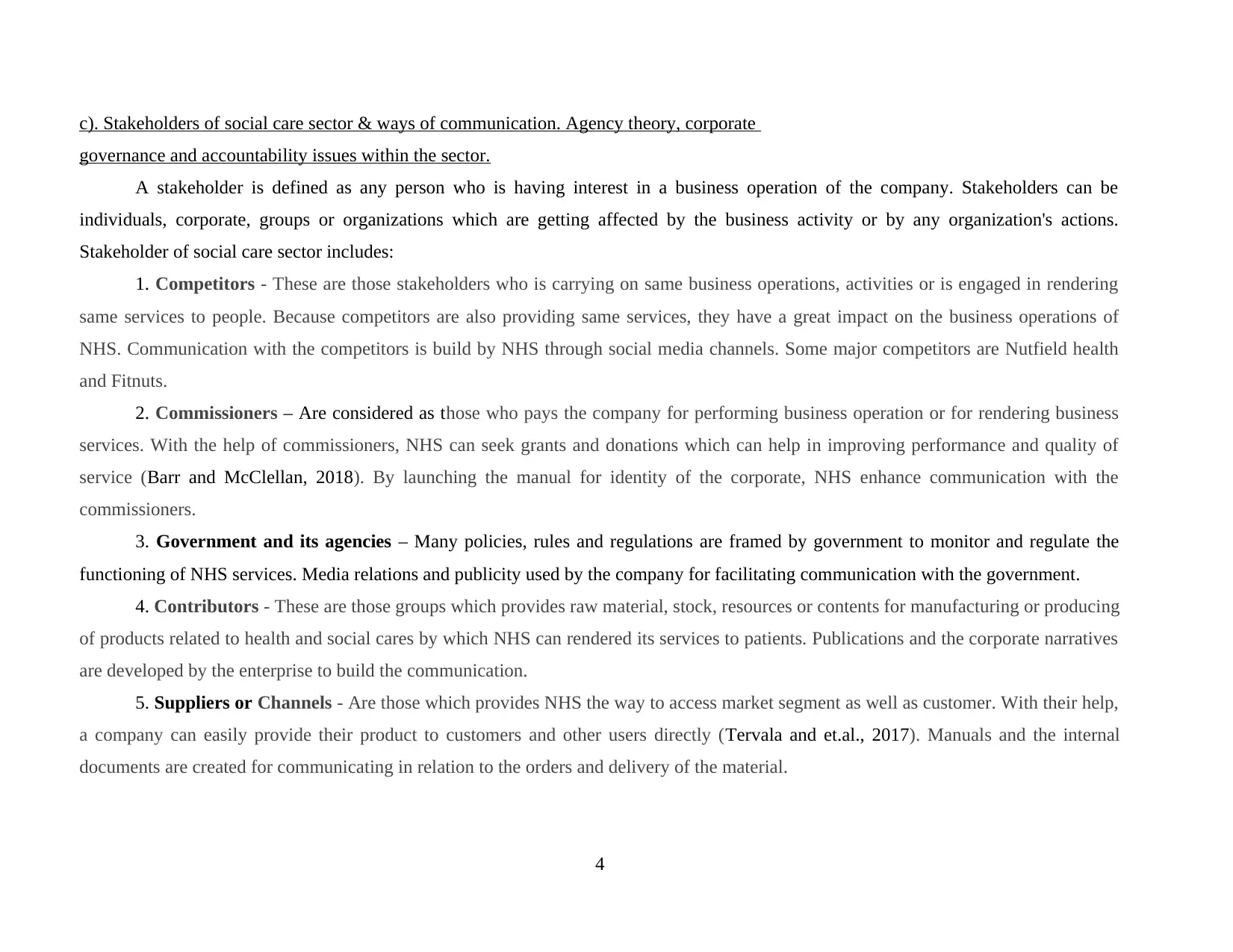
c). Stakeholders of social care sector & ways of communication. Agency theory, corporate
governance and accountability issues within the sector.
A stakeholder is defined as any person who is having interest in a business operation of the company. Stakeholders can be
individuals, corporate, groups or organizations which are getting affected by the business activity or by any organization's actions.
Stakeholder of social care sector includes:
1. Competitors - These are those stakeholders who is carrying on same business operations, activities or is engaged in rendering
same services to people. Because competitors are also providing same services, they have a great impact on the business operations of
NHS. Communication with the competitors is build by NHS through social media channels. Some major competitors are Nutfield health
and Fitnuts.
2. Commissioners – Are considered as those who pays the company for performing business operation or for rendering business
services. With the help of commissioners, NHS can seek grants and donations which can help in improving performance and quality of
service (Barr and McClellan, 2018). By launching the manual for identity of the corporate, NHS enhance communication with the
commissioners.
3. Government and its agencies – Many policies, rules and regulations are framed by government to monitor and regulate the
functioning of NHS services. Media relations and publicity used by the company for facilitating communication with the government.
4. Contributors - These are those groups which provides raw material, stock, resources or contents for manufacturing or producing
of products related to health and social cares by which NHS can rendered its services to patients. Publications and the corporate narratives
are developed by the enterprise to build the communication.
5. Suppliers or Channels - Are those which provides NHS the way to access market segment as well as customer. With their help,
a company can easily provide their product to customers and other users directly (Tervala and et.al., 2017). Manuals and the internal
documents are created for communicating in relation to the orders and delivery of the material.
4
governance and accountability issues within the sector.
A stakeholder is defined as any person who is having interest in a business operation of the company. Stakeholders can be
individuals, corporate, groups or organizations which are getting affected by the business activity or by any organization's actions.
Stakeholder of social care sector includes:
1. Competitors - These are those stakeholders who is carrying on same business operations, activities or is engaged in rendering
same services to people. Because competitors are also providing same services, they have a great impact on the business operations of
NHS. Communication with the competitors is build by NHS through social media channels. Some major competitors are Nutfield health
and Fitnuts.
2. Commissioners – Are considered as those who pays the company for performing business operation or for rendering business
services. With the help of commissioners, NHS can seek grants and donations which can help in improving performance and quality of
service (Barr and McClellan, 2018). By launching the manual for identity of the corporate, NHS enhance communication with the
commissioners.
3. Government and its agencies – Many policies, rules and regulations are framed by government to monitor and regulate the
functioning of NHS services. Media relations and publicity used by the company for facilitating communication with the government.
4. Contributors - These are those groups which provides raw material, stock, resources or contents for manufacturing or producing
of products related to health and social cares by which NHS can rendered its services to patients. Publications and the corporate narratives
are developed by the enterprise to build the communication.
5. Suppliers or Channels - Are those which provides NHS the way to access market segment as well as customer. With their help,
a company can easily provide their product to customers and other users directly (Tervala and et.al., 2017). Manuals and the internal
documents are created for communicating in relation to the orders and delivery of the material.
4
⊘ This is a preview!⊘
Do you want full access?
Subscribe today to unlock all pages.

Trusted by 1+ million students worldwide
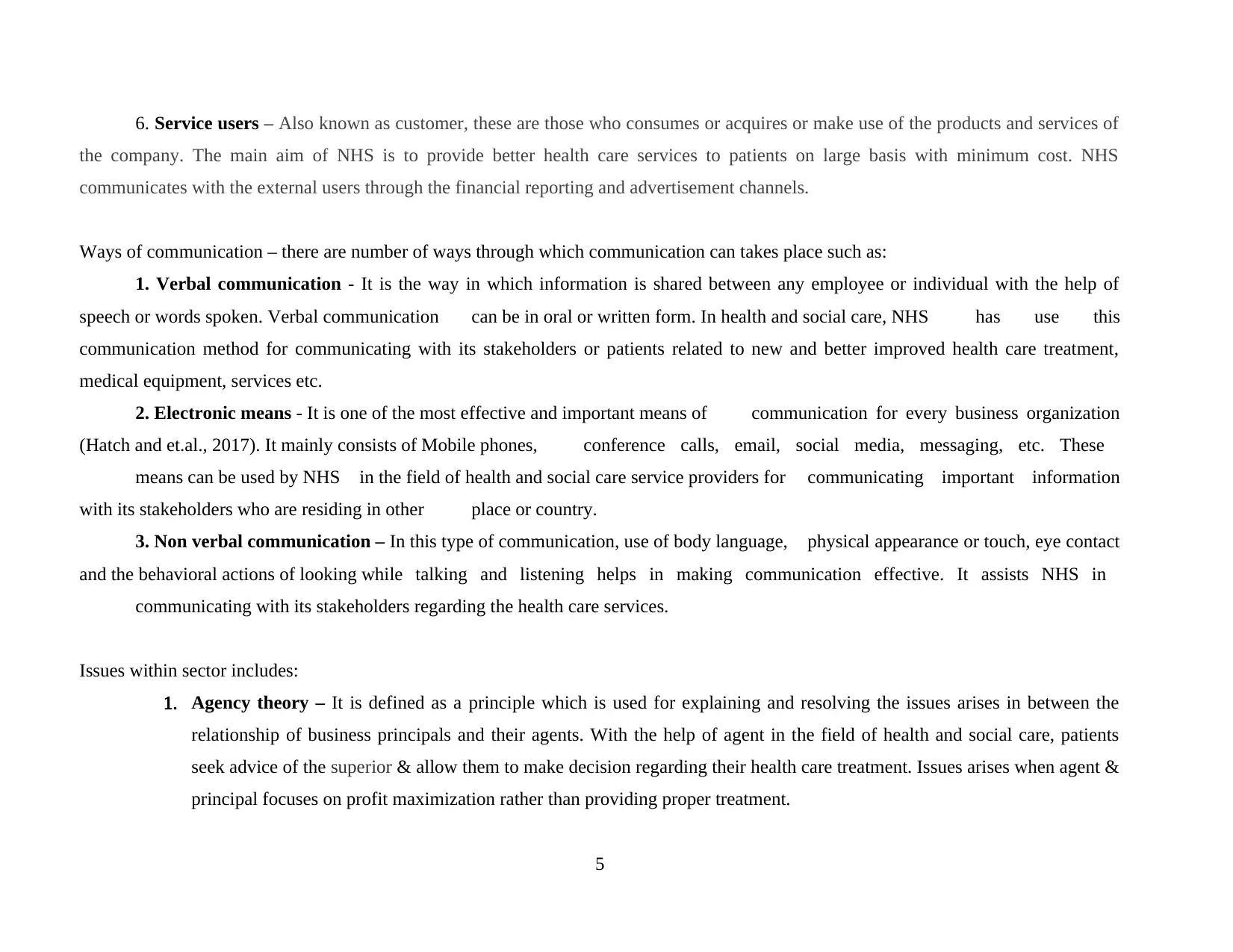
6. Service users – Also known as customer, these are those who consumes or acquires or make use of the products and services of
the company. The main aim of NHS is to provide better health care services to patients on large basis with minimum cost. NHS
communicates with the external users through the financial reporting and advertisement channels.
Ways of communication – there are number of ways through which communication can takes place such as:
1. Verbal communication - It is the way in which information is shared between any employee or individual with the help of
speech or words spoken. Verbal communication can be in oral or written form. In health and social care, NHS has use this
communication method for communicating with its stakeholders or patients related to new and better improved health care treatment,
medical equipment, services etc.
2. Electronic means - It is one of the most effective and important means of communication for every business organization
(Hatch and et.al., 2017). It mainly consists of Mobile phones, conference calls, email, social media, messaging, etc. These
means can be used by NHS in the field of health and social care service providers for communicating important information
with its stakeholders who are residing in other place or country.
3. Non verbal communication – In this type of communication, use of body language, physical appearance or touch, eye contact
and the behavioral actions of looking while talking and listening helps in making communication effective. It assists NHS in
communicating with its stakeholders regarding the health care services.
Issues within sector includes:
1. Agency theory – It is defined as a principle which is used for explaining and resolving the issues arises in between the
relationship of business principals and their agents. With the help of agent in the field of health and social care, patients
seek advice of the superior & allow them to make decision regarding their health care treatment. Issues arises when agent &
principal focuses on profit maximization rather than providing proper treatment.
5
the company. The main aim of NHS is to provide better health care services to patients on large basis with minimum cost. NHS
communicates with the external users through the financial reporting and advertisement channels.
Ways of communication – there are number of ways through which communication can takes place such as:
1. Verbal communication - It is the way in which information is shared between any employee or individual with the help of
speech or words spoken. Verbal communication can be in oral or written form. In health and social care, NHS has use this
communication method for communicating with its stakeholders or patients related to new and better improved health care treatment,
medical equipment, services etc.
2. Electronic means - It is one of the most effective and important means of communication for every business organization
(Hatch and et.al., 2017). It mainly consists of Mobile phones, conference calls, email, social media, messaging, etc. These
means can be used by NHS in the field of health and social care service providers for communicating important information
with its stakeholders who are residing in other place or country.
3. Non verbal communication – In this type of communication, use of body language, physical appearance or touch, eye contact
and the behavioral actions of looking while talking and listening helps in making communication effective. It assists NHS in
communicating with its stakeholders regarding the health care services.
Issues within sector includes:
1. Agency theory – It is defined as a principle which is used for explaining and resolving the issues arises in between the
relationship of business principals and their agents. With the help of agent in the field of health and social care, patients
seek advice of the superior & allow them to make decision regarding their health care treatment. Issues arises when agent &
principal focuses on profit maximization rather than providing proper treatment.
5
Paraphrase This Document
Need a fresh take? Get an instant paraphrase of this document with our AI Paraphraser
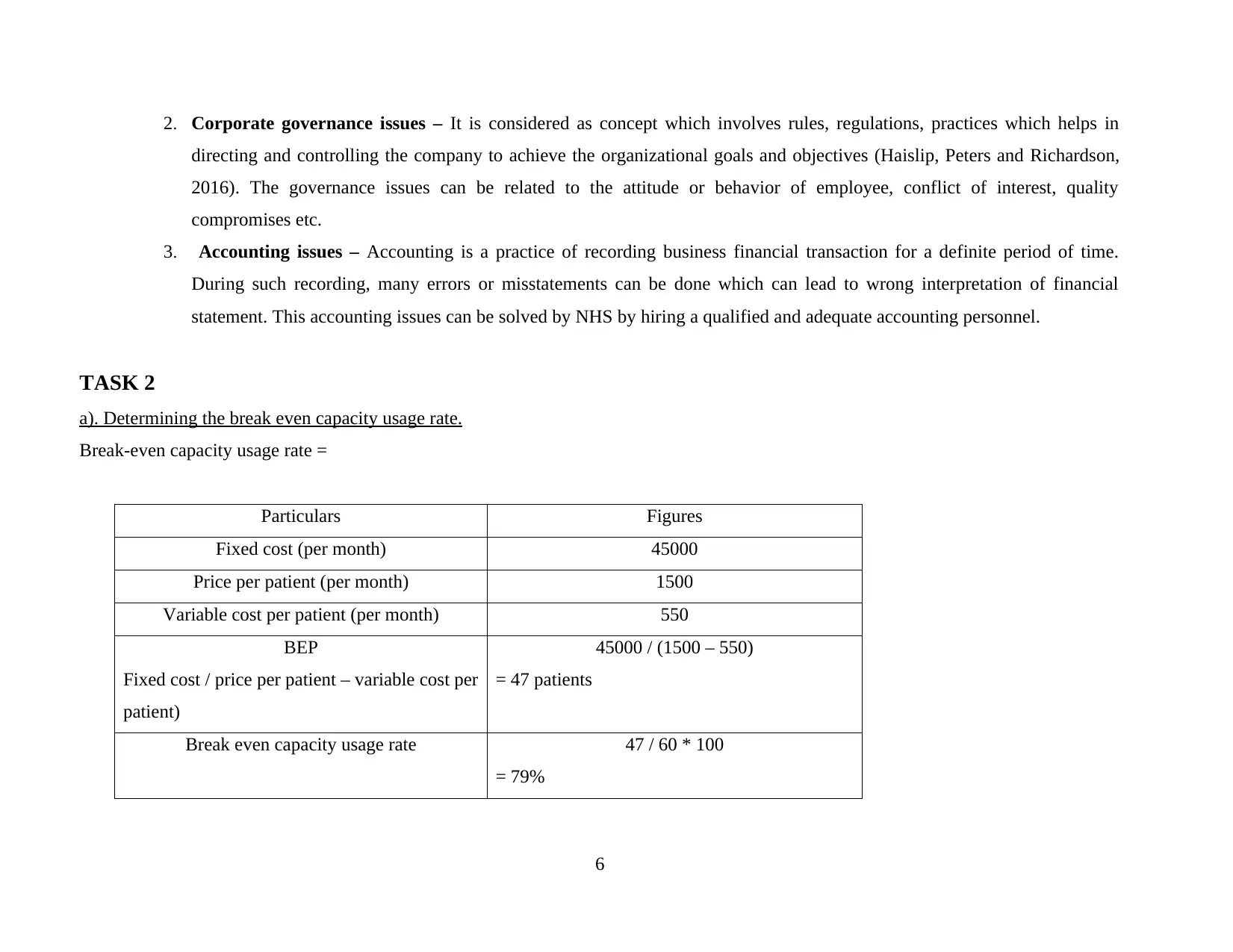
2. Corporate governance issues – It is considered as concept which involves rules, regulations, practices which helps in
directing and controlling the company to achieve the organizational goals and objectives (Haislip, Peters and Richardson,
2016). The governance issues can be related to the attitude or behavior of employee, conflict of interest, quality
compromises etc.
3. Accounting issues – Accounting is a practice of recording business financial transaction for a definite period of time.
During such recording, many errors or misstatements can be done which can lead to wrong interpretation of financial
statement. This accounting issues can be solved by NHS by hiring a qualified and adequate accounting personnel.
TASK 2
a). Determining the break even capacity usage rate.
Break-even capacity usage rate =
Particulars Figures
Fixed cost (per month) 45000
Price per patient (per month) 1500
Variable cost per patient (per month) 550
BEP
Fixed cost / price per patient – variable cost per
patient)
45000 / (1500 – 550)
= 47 patients
Break even capacity usage rate 47 / 60 * 100
= 79%
6
directing and controlling the company to achieve the organizational goals and objectives (Haislip, Peters and Richardson,
2016). The governance issues can be related to the attitude or behavior of employee, conflict of interest, quality
compromises etc.
3. Accounting issues – Accounting is a practice of recording business financial transaction for a definite period of time.
During such recording, many errors or misstatements can be done which can lead to wrong interpretation of financial
statement. This accounting issues can be solved by NHS by hiring a qualified and adequate accounting personnel.
TASK 2
a). Determining the break even capacity usage rate.
Break-even capacity usage rate =
Particulars Figures
Fixed cost (per month) 45000
Price per patient (per month) 1500
Variable cost per patient (per month) 550
BEP
Fixed cost / price per patient – variable cost per
patient)
45000 / (1500 – 550)
= 47 patients
Break even capacity usage rate 47 / 60 * 100
= 79%
6
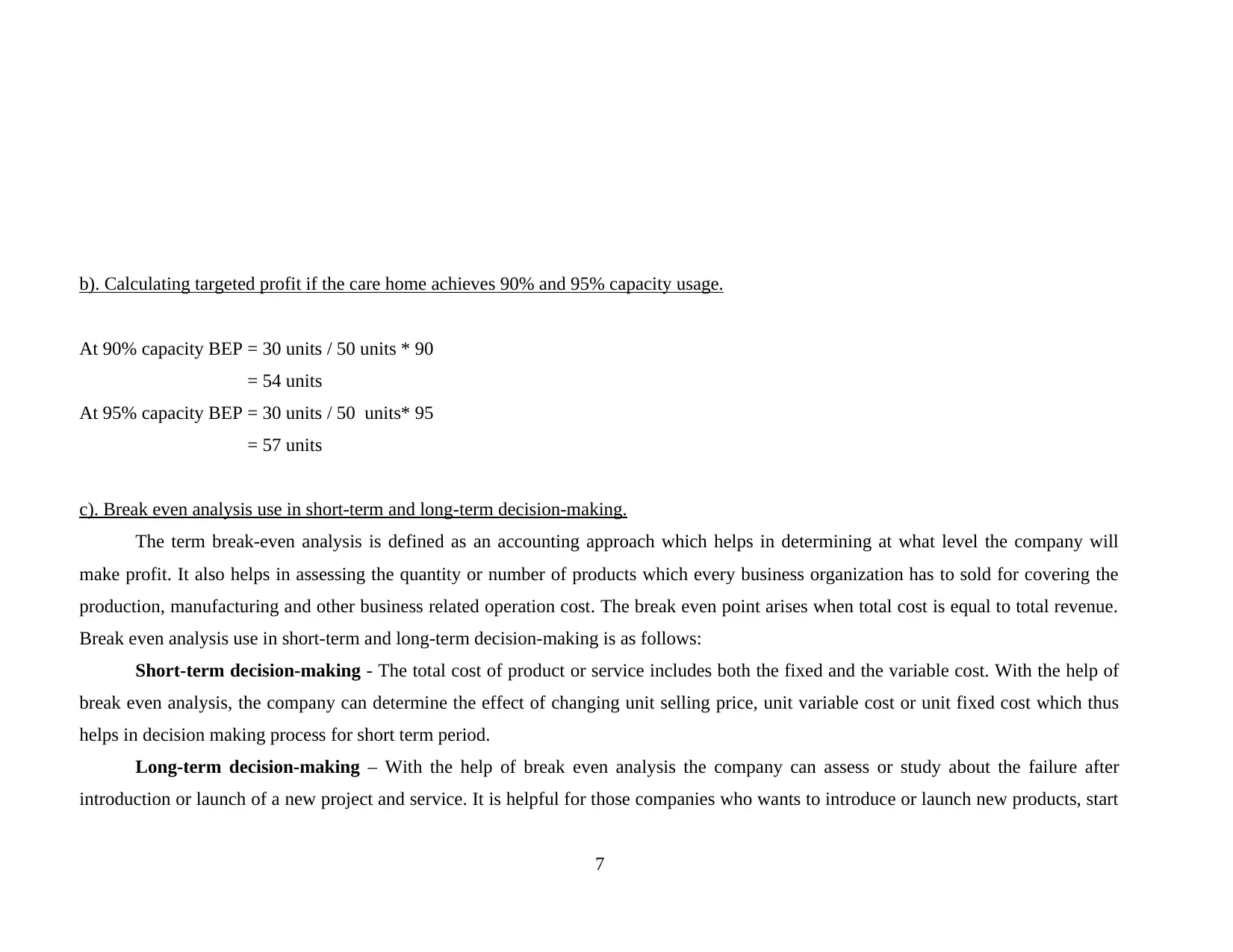
b). Calculating targeted profit if the care home achieves 90% and 95% capacity usage.
At 90% capacity BEP = 30 units / 50 units * 90
= 54 units
At 95% capacity BEP = 30 units / 50 units* 95
= 57 units
c). Break even analysis use in short-term and long-term decision-making.
The term break-even analysis is defined as an accounting approach which helps in determining at what level the company will
make profit. It also helps in assessing the quantity or number of products which every business organization has to sold for covering the
production, manufacturing and other business related operation cost. The break even point arises when total cost is equal to total revenue.
Break even analysis use in short-term and long-term decision-making is as follows:
Short-term decision-making - The total cost of product or service includes both the fixed and the variable cost. With the help of
break even analysis, the company can determine the effect of changing unit selling price, unit variable cost or unit fixed cost which thus
helps in decision making process for short term period.
Long-term decision-making – With the help of break even analysis the company can assess or study about the failure after
introduction or launch of a new project and service. It is helpful for those companies who wants to introduce or launch new products, start
7
At 90% capacity BEP = 30 units / 50 units * 90
= 54 units
At 95% capacity BEP = 30 units / 50 units* 95
= 57 units
c). Break even analysis use in short-term and long-term decision-making.
The term break-even analysis is defined as an accounting approach which helps in determining at what level the company will
make profit. It also helps in assessing the quantity or number of products which every business organization has to sold for covering the
production, manufacturing and other business related operation cost. The break even point arises when total cost is equal to total revenue.
Break even analysis use in short-term and long-term decision-making is as follows:
Short-term decision-making - The total cost of product or service includes both the fixed and the variable cost. With the help of
break even analysis, the company can determine the effect of changing unit selling price, unit variable cost or unit fixed cost which thus
helps in decision making process for short term period.
Long-term decision-making – With the help of break even analysis the company can assess or study about the failure after
introduction or launch of a new project and service. It is helpful for those companies who wants to introduce or launch new products, start
7
⊘ This is a preview!⊘
Do you want full access?
Subscribe today to unlock all pages.

Trusted by 1+ million students worldwide
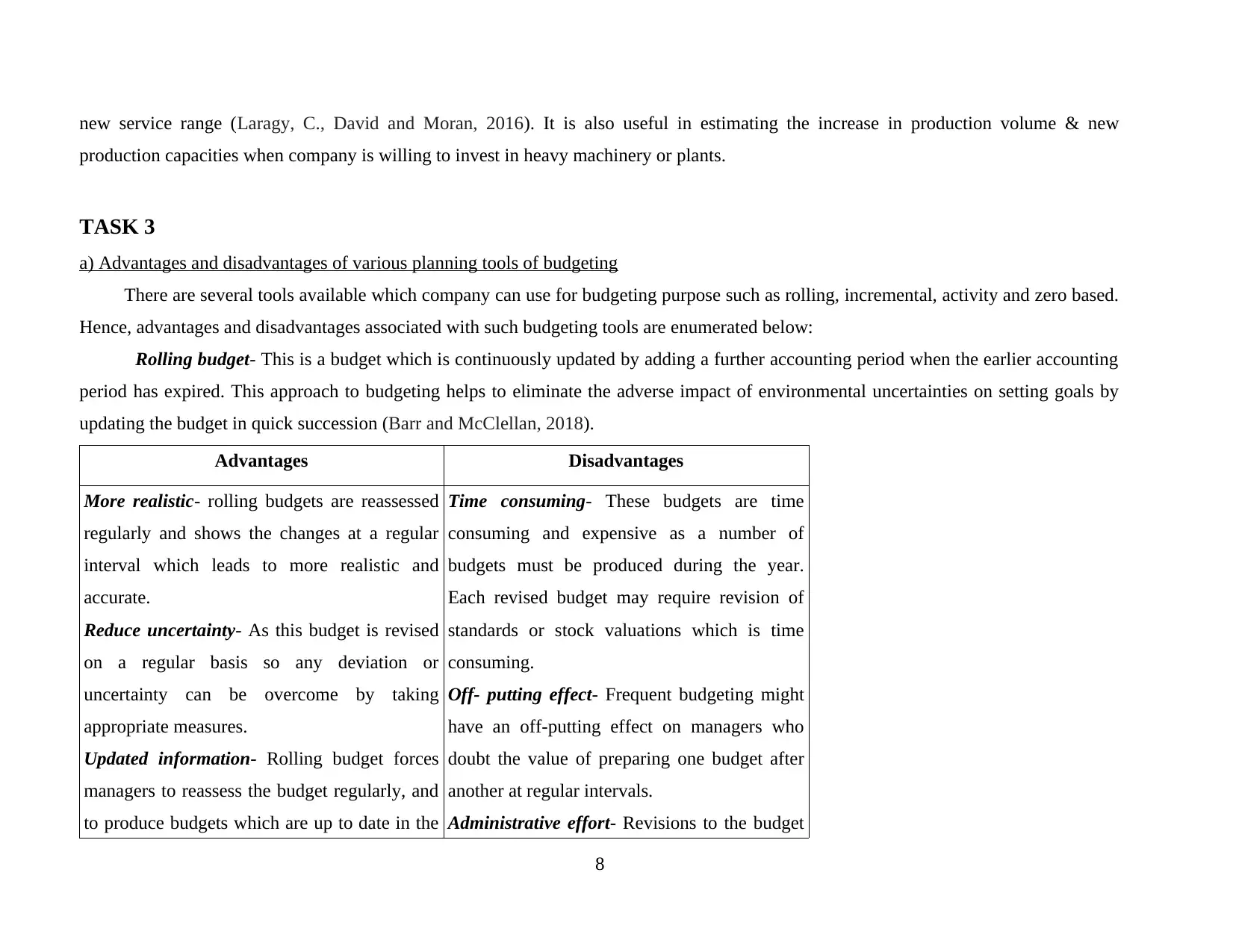
new service range (Laragy, C., David and Moran, 2016). It is also useful in estimating the increase in production volume & new
production capacities when company is willing to invest in heavy machinery or plants.
TASK 3
a) Advantages and disadvantages of various planning tools of budgeting
There are several tools available which company can use for budgeting purpose such as rolling, incremental, activity and zero based.
Hence, advantages and disadvantages associated with such budgeting tools are enumerated below:
Rolling budget- This is a budget which is continuously updated by adding a further accounting period when the earlier accounting
period has expired. This approach to budgeting helps to eliminate the adverse impact of environmental uncertainties on setting goals by
updating the budget in quick succession (Barr and McClellan, 2018).
Advantages Disadvantages
More realistic- rolling budgets are reassessed
regularly and shows the changes at a regular
interval which leads to more realistic and
accurate.
Reduce uncertainty- As this budget is revised
on a regular basis so any deviation or
uncertainty can be overcome by taking
appropriate measures.
Updated information- Rolling budget forces
managers to reassess the budget regularly, and
to produce budgets which are up to date in the
Time consuming- These budgets are time
consuming and expensive as a number of
budgets must be produced during the year.
Each revised budget may require revision of
standards or stock valuations which is time
consuming.
Off- putting effect- Frequent budgeting might
have an off-putting effect on managers who
doubt the value of preparing one budget after
another at regular intervals.
Administrative effort- Revisions to the budget
8
production capacities when company is willing to invest in heavy machinery or plants.
TASK 3
a) Advantages and disadvantages of various planning tools of budgeting
There are several tools available which company can use for budgeting purpose such as rolling, incremental, activity and zero based.
Hence, advantages and disadvantages associated with such budgeting tools are enumerated below:
Rolling budget- This is a budget which is continuously updated by adding a further accounting period when the earlier accounting
period has expired. This approach to budgeting helps to eliminate the adverse impact of environmental uncertainties on setting goals by
updating the budget in quick succession (Barr and McClellan, 2018).
Advantages Disadvantages
More realistic- rolling budgets are reassessed
regularly and shows the changes at a regular
interval which leads to more realistic and
accurate.
Reduce uncertainty- As this budget is revised
on a regular basis so any deviation or
uncertainty can be overcome by taking
appropriate measures.
Updated information- Rolling budget forces
managers to reassess the budget regularly, and
to produce budgets which are up to date in the
Time consuming- These budgets are time
consuming and expensive as a number of
budgets must be produced during the year.
Each revised budget may require revision of
standards or stock valuations which is time
consuming.
Off- putting effect- Frequent budgeting might
have an off-putting effect on managers who
doubt the value of preparing one budget after
another at regular intervals.
Administrative effort- Revisions to the budget
8
Paraphrase This Document
Need a fresh take? Get an instant paraphrase of this document with our AI Paraphraser
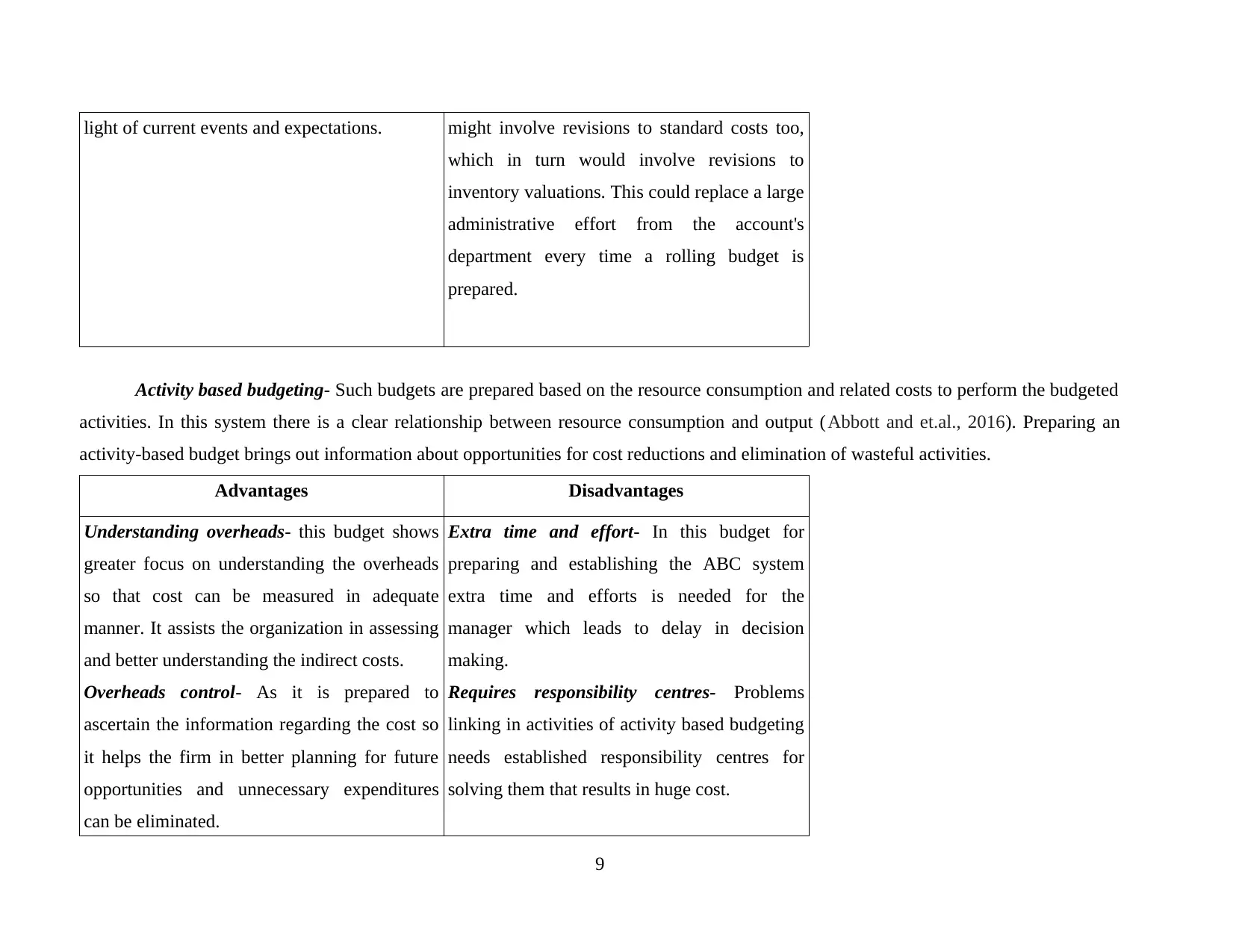
light of current events and expectations. might involve revisions to standard costs too,
which in turn would involve revisions to
inventory valuations. This could replace a large
administrative effort from the account's
department every time a rolling budget is
prepared.
Activity based budgeting- Such budgets are prepared based on the resource consumption and related costs to perform the budgeted
activities. In this system there is a clear relationship between resource consumption and output (Abbott and et.al., 2016). Preparing an
activity-based budget brings out information about opportunities for cost reductions and elimination of wasteful activities.
Advantages Disadvantages
Understanding overheads- this budget shows
greater focus on understanding the overheads
so that cost can be measured in adequate
manner. It assists the organization in assessing
and better understanding the indirect costs.
Overheads control- As it is prepared to
ascertain the information regarding the cost so
it helps the firm in better planning for future
opportunities and unnecessary expenditures
can be eliminated.
Extra time and effort- In this budget for
preparing and establishing the ABC system
extra time and efforts is needed for the
manager which leads to delay in decision
making.
Requires responsibility centres- Problems
linking in activities of activity based budgeting
needs established responsibility centres for
solving them that results in huge cost.
9
which in turn would involve revisions to
inventory valuations. This could replace a large
administrative effort from the account's
department every time a rolling budget is
prepared.
Activity based budgeting- Such budgets are prepared based on the resource consumption and related costs to perform the budgeted
activities. In this system there is a clear relationship between resource consumption and output (Abbott and et.al., 2016). Preparing an
activity-based budget brings out information about opportunities for cost reductions and elimination of wasteful activities.
Advantages Disadvantages
Understanding overheads- this budget shows
greater focus on understanding the overheads
so that cost can be measured in adequate
manner. It assists the organization in assessing
and better understanding the indirect costs.
Overheads control- As it is prepared to
ascertain the information regarding the cost so
it helps the firm in better planning for future
opportunities and unnecessary expenditures
can be eliminated.
Extra time and effort- In this budget for
preparing and establishing the ABC system
extra time and efforts is needed for the
manager which leads to delay in decision
making.
Requires responsibility centres- Problems
linking in activities of activity based budgeting
needs established responsibility centres for
solving them that results in huge cost.
9
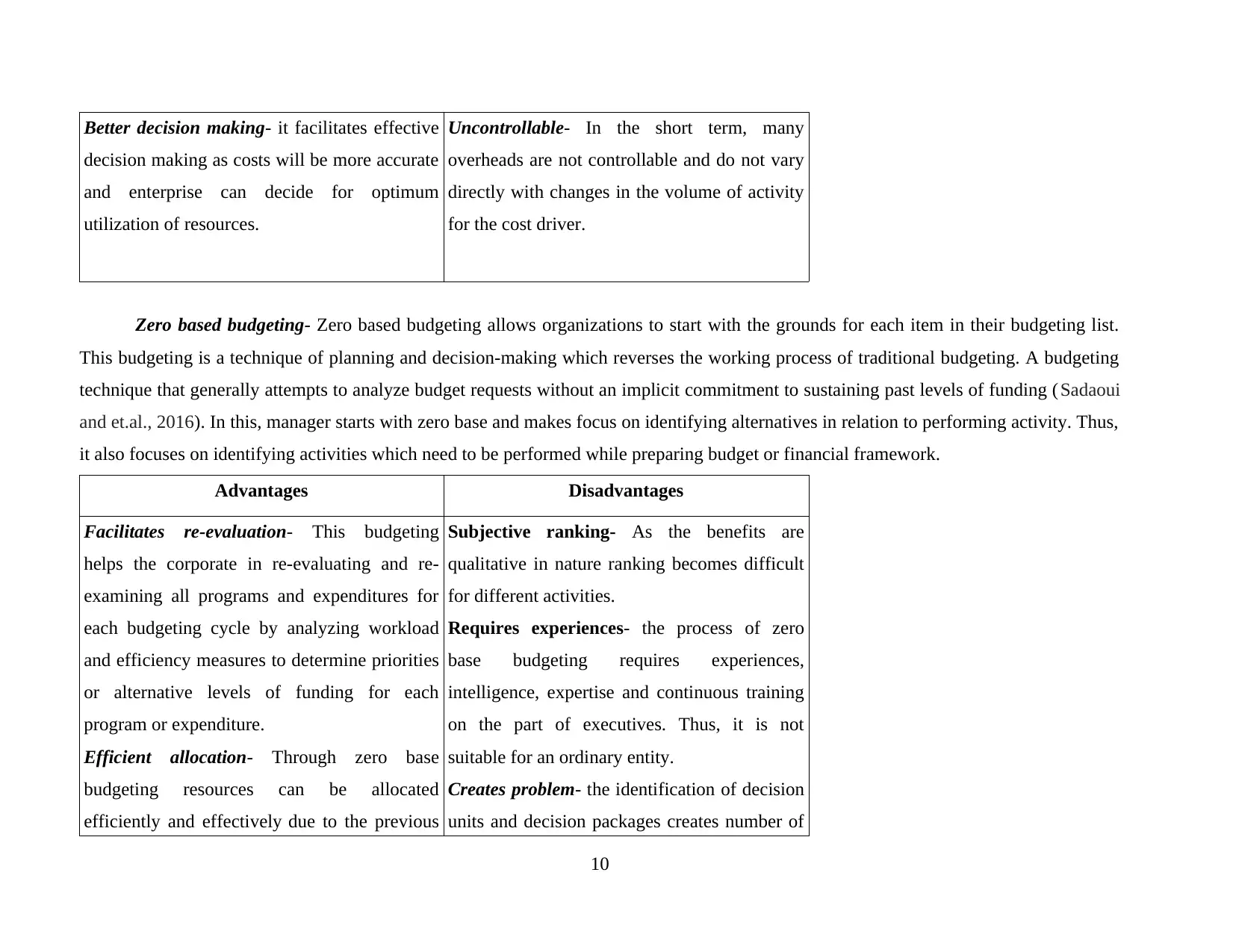
Better decision making- it facilitates effective
decision making as costs will be more accurate
and enterprise can decide for optimum
utilization of resources.
Uncontrollable- In the short term, many
overheads are not controllable and do not vary
directly with changes in the volume of activity
for the cost driver.
Zero based budgeting- Zero based budgeting allows organizations to start with the grounds for each item in their budgeting list.
This budgeting is a technique of planning and decision-making which reverses the working process of traditional budgeting. A budgeting
technique that generally attempts to analyze budget requests without an implicit commitment to sustaining past levels of funding ( Sadaoui
and et.al., 2016). In this, manager starts with zero base and makes focus on identifying alternatives in relation to performing activity. Thus,
it also focuses on identifying activities which need to be performed while preparing budget or financial framework.
Advantages Disadvantages
Facilitates re-evaluation- This budgeting
helps the corporate in re-evaluating and re-
examining all programs and expenditures for
each budgeting cycle by analyzing workload
and efficiency measures to determine priorities
or alternative levels of funding for each
program or expenditure.
Efficient allocation- Through zero base
budgeting resources can be allocated
efficiently and effectively due to the previous
Subjective ranking- As the benefits are
qualitative in nature ranking becomes difficult
for different activities.
Requires experiences- the process of zero
base budgeting requires experiences,
intelligence, expertise and continuous training
on the part of executives. Thus, it is not
suitable for an ordinary entity.
Creates problem- the identification of decision
units and decision packages creates number of
10
decision making as costs will be more accurate
and enterprise can decide for optimum
utilization of resources.
Uncontrollable- In the short term, many
overheads are not controllable and do not vary
directly with changes in the volume of activity
for the cost driver.
Zero based budgeting- Zero based budgeting allows organizations to start with the grounds for each item in their budgeting list.
This budgeting is a technique of planning and decision-making which reverses the working process of traditional budgeting. A budgeting
technique that generally attempts to analyze budget requests without an implicit commitment to sustaining past levels of funding ( Sadaoui
and et.al., 2016). In this, manager starts with zero base and makes focus on identifying alternatives in relation to performing activity. Thus,
it also focuses on identifying activities which need to be performed while preparing budget or financial framework.
Advantages Disadvantages
Facilitates re-evaluation- This budgeting
helps the corporate in re-evaluating and re-
examining all programs and expenditures for
each budgeting cycle by analyzing workload
and efficiency measures to determine priorities
or alternative levels of funding for each
program or expenditure.
Efficient allocation- Through zero base
budgeting resources can be allocated
efficiently and effectively due to the previous
Subjective ranking- As the benefits are
qualitative in nature ranking becomes difficult
for different activities.
Requires experiences- the process of zero
base budgeting requires experiences,
intelligence, expertise and continuous training
on the part of executives. Thus, it is not
suitable for an ordinary entity.
Creates problem- the identification of decision
units and decision packages creates number of
10
⊘ This is a preview!⊘
Do you want full access?
Subscribe today to unlock all pages.

Trusted by 1+ million students worldwide
1 out of 20
Related Documents
Your All-in-One AI-Powered Toolkit for Academic Success.
+13062052269
info@desklib.com
Available 24*7 on WhatsApp / Email
![[object Object]](/_next/static/media/star-bottom.7253800d.svg)
Unlock your academic potential
Copyright © 2020–2025 A2Z Services. All Rights Reserved. Developed and managed by ZUCOL.


